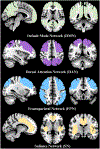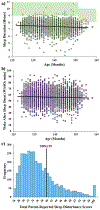Getting a Good Night's Sleep: Associations Between Sleep Duration and Parent-Reported Sleep Quality on Default Mode Network Connectivity in Youth
- PMID: 36872118
- PMCID: PMC10198813
- DOI: 10.1016/j.jadohealth.2023.01.010
Getting a Good Night's Sleep: Associations Between Sleep Duration and Parent-Reported Sleep Quality on Default Mode Network Connectivity in Youth
Abstract
Purpose: Sleep plays an important role in healthy neurocognitive development, and poor sleep is linked to cognitive and emotional dysfunction. Studies in adults suggest that shorter sleep duration and poor sleep quality may disrupt core neurocognitive networks, particularly the default mode network (DMN)-a network implicated in internal cognitive processing and rumination. Here, we examine the relationships between sleep and within- and between-network resting-state functional connectivity (rs-FC) of the DMN in youth.
Methods: This study included 3,798 youth (11.9 ± 0.6 years, 47.5% female) from the Adolescent Brain Cognitive Development cohort. Sleep duration and wake after sleep onset (WASO) were quantified using Fitbit watch recordings, and parent-reported sleep disturbances were measured using the Sleep Disturbance Scale for Children. We focused on rs-FC between the DMN and anticorrelated networks (i.e., dorsal attention network [DAN], frontoparietal network, salience network).
Results: Both shorter sleep duration and greater sleep disturbances were associated with weaker within-network DMN rs-FC. Shorter sleep duration was also associated with weaker anticorrelation (i.e., higher rs-FC) between the DMN and two anticorrelated networks: the DAN and frontoparietal network. Greater WASO was also associated with DMN-DAN rs-FC, and the effects of WASO on rs-FC were most pronounced among children who slept fewer hours/night.
Discussion: Together, these data suggest that different aspects of sleep are associated with distinct and interactive alterations in resting-state brain networks. Alterations in core neurocognitive networks may confer increased risk for emotional psychopathology and attention-related vulnerabilities. Our findings contribute to the growing number of studies demonstrating the importance of healthy sleep practices in youth.
Keywords: Default mode network; Dorsal attention network; Frontoparietal network; Resting-state functional connectivity; Salience network; Sleep disturbances.
Copyright © 2023 Society for Adolescent Health and Medicine. Published by Elsevier Inc. All rights reserved.
Figures



Similar articles
-
Frontoparietal and default mode network connectivity varies with age and intelligence.Dev Cogn Neurosci. 2021 Apr;48:100928. doi: 10.1016/j.dcn.2021.100928. Epub 2021 Jan 27. Dev Cogn Neurosci. 2021. PMID: 33517109 Free PMC article.
-
Altered attention networks and DMN in refractory epilepsy: A resting-state functional and causal connectivity study.Epilepsy Behav. 2018 Nov;88:81-86. doi: 10.1016/j.yebeh.2018.06.045. Epub 2018 Sep 19. Epilepsy Behav. 2018. PMID: 30243110 Clinical Trial.
-
Investigation of Psychiatric and Neuropsychological Correlates of Default Mode Network and Dorsal Attention Network Anticorrelation in Children.Cereb Cortex. 2020 Nov 3;30(12):6083-6096. doi: 10.1093/cercor/bhaa143. Cereb Cortex. 2020. PMID: 32591777 Free PMC article.
-
Mapping cognitive and emotional networks in neurosurgical patients using resting-state functional magnetic resonance imaging.Neurosurg Focus. 2020 Feb 1;48(2):E9. doi: 10.3171/2019.11.FOCUS19773. Neurosurg Focus. 2020. PMID: 32006946 Free PMC article. Review.
-
Similarity and difference in large-scale functional network alternations between behavioral addictions and substance use disorder: a comparative meta-analysis.Psychol Med. 2024 Feb;54(3):473-487. doi: 10.1017/S0033291723003434. Epub 2023 Dec 4. Psychol Med. 2024. PMID: 38047402 Review.
Cited by
-
Cardiorespiratory Fitness and Sleep, but not Physical Activity, are Associated with Functional Connectivity in Older Adults.Sports Med Open. 2024 Oct 19;10(1):113. doi: 10.1186/s40798-024-00778-6. Sports Med Open. 2024. PMID: 39425826 Free PMC article.
-
Impact of Environmental Noise and Sleep Health on Pediatric Hypertension Incidence: ABCD Study.J Am Heart Assoc. 2024 Nov 19;13(22):e037503. doi: 10.1161/JAHA.124.037503. Epub 2024 Nov 11. J Am Heart Assoc. 2024. PMID: 39526341 Free PMC article.
-
Somatomotor Disconnection Links Sleep Duration With Socioeconomic Context, Screen Time, Cognition, and Psychopathology.Biol Psychiatry Glob Open Sci. 2025 Apr 30;5(4):100522. doi: 10.1016/j.bpsgos.2025.100522. eCollection 2025 Jul. Biol Psychiatry Glob Open Sci. 2025. PMID: 40530340 Free PMC article.
-
Puberty interacts with sleep and brain network organization to predict mental health.Front Hum Neurosci. 2024 Sep 27;18:1379945. doi: 10.3389/fnhum.2024.1379945. eCollection 2024. Front Hum Neurosci. 2024. PMID: 39398321 Free PMC article.
-
Genetically Supported Causality between Brain Structural Connectome and Sleep Duration in Children: A Two-Sample Mendelian Randomization Study.eNeuro. 2024 Dec 17;11(12):ENEURO.0267-24.2024. doi: 10.1523/ENEURO.0267-24.2024. Print 2024 Dec. eNeuro. 2024. PMID: 39632091 Free PMC article.
References
-
- Vriend JL, Davidson FD, Corkum PV, Rusak B, Chambers CT, McLaughlin EN. Manipulating sleep duration alters emotional functioning and cognitive performance in children. J Pediatr Psychol. 2013;38(10):1058–1069. - PubMed
Publication types
MeSH terms
Grants and funding
- U24 DA041147/DA/NIDA NIH HHS/United States
- R21 HD105882/HD/NICHD NIH HHS/United States
- U01 DA041120/DA/NIDA NIH HHS/United States
- U01 DA041093/DA/NIDA NIH HHS/United States
- U24 DA041123/DA/NIDA NIH HHS/United States
- K01 MH119241/MH/NIMH NIH HHS/United States
- U01 DA041156/DA/NIDA NIH HHS/United States
- U01 DA041025/DA/NIDA NIH HHS/United States
- U01 DA041089/DA/NIDA NIH HHS/United States
- U01 DA041106/DA/NIDA NIH HHS/United States
- U01 DA041117/DA/NIDA NIH HHS/United States
- U01 DA041148/DA/NIDA NIH HHS/United States
- R01 MH121079/MH/NIMH NIH HHS/United States
- U01 DA041174/DA/NIDA NIH HHS/United States
- U01 DA041134/DA/NIDA NIH HHS/United States
- U01 DA041022/DA/NIDA NIH HHS/United States
- U01 DA041028/DA/NIDA NIH HHS/United States
- U01 DA041048/DA/NIDA NIH HHS/United States
LinkOut - more resources
Full Text Sources
Medical
Miscellaneous

